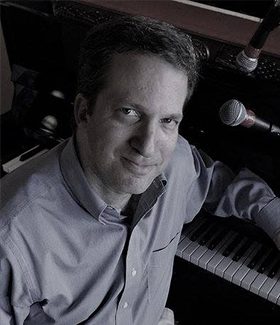Davenport’s Putnam Museum Works With Many to Broaden Its Quad-Cities Exhibit
Saturday In The Arts is a weekly look at a personality, place, trend or topic of interest to the Quad-Cities. It runs every Saturday morning on your site for fun, free, local entertainment and features, QuadCities.com.

The traveling exhibit “Race: Are We So Different?,” in 2019 at Davenport’s Putnam Museum, had a profound impact on visitors, staff and those who took part in many related discussions.
Building on that success and a Quad-Cities-wide effort to improve racial equity this year – amidst national reckonings regarding racial injustice – Putnam president/CEO Rachael Mullins has big goals.
She’s working with several local organizations and leaders to transform a permanent Q-C history exhibit (“River, Prairie and People”) so that it’s more inclusive and representative of the area’s increasingly diverse population.
“We’re digging deeper on some of those stories that are not currently represented and should be,” Mullins said recently, “and also closing the gap in our more recent history to make sure the content is relevant to current generations and their more immediate history.”
At the museum and science center (1717 W. 12th St., Davenport), River, Prairie and People takes visitors back in time as they discover what the Q-C was like for its earliest inhabitants, and how the Mississippi River helped form the community.
It shows how the region took shape through milestones such as the founding of Davenport by Antoine LeClaire, and how the Civil War brought about the Rock Island Arsenal. Its artifacts include the famous Davenport Tablets, Bix Beiderbecke’s cornet, and shows how John
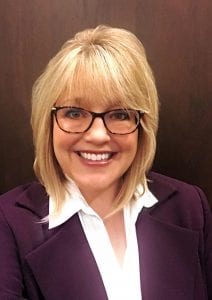
Rachael Mullins has been Putnam president/CEO since July 2019.
Deere built his company here.
A broad coalition has formed to re-examine the local history exhibit, and the Putnam plans to rename it as well, aiming for a finished transformation by 2022.
Mullins said the current working title – “The Ground on Which We Stand” — refers to “the geography we all share in the Quad-Cities, but also an understanding of the incredible impact of the heritage of our community in shaping our collective values,” she said.

An image from the “Race: Are We So Different?” exhibit.
“The ground on which we stand was once owned by the Sauk and Fox people,” she said of Native American tribes in the area. “It was protected by the Black infantry that came from Kentucky in the Civil War. The ground on which we stand was built by the Hispanic community, who really built the railroad and so much industry in our community.
“And now the ground on which we stand is embraced as home to so many people from around the world that cherish the opportunity to be a new American and consider themselves a Quad Citizen,” Mullins said.
The timeframe includes pulling together historical research, and this spring there will be a preview displayed of some of that content, she said. The Putnam will encourage the public to tell them about their own personal history.
“We’re asking the community to help curate the exhibit,” Mullins said. “We’ll have several opportunities for people to connect and talk with us about if this content is on track.”
By fall 2021, they’ll finalize the themes and content of the exhibit, and build it (with new school curriculum) to be ready by fall 2022, she said.
The new exhibit will be in the current space, and the Putnam is raising money for that transformation, Mullins said. Some current artifacts will remain, but expanded upon to “make sure we’re more representative of the stories that should be included,” she said.
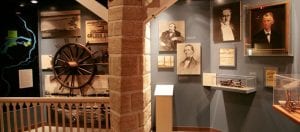
A decidedly white view of Quad-Cities history at the Putnam Museum.
For example, there’s a Civil War display and the role of Iowa in the abolitionist movement, but they’re missing stories of African-Americans’ arrival in the Q-C after the Civil War, Mullins said. “There was a thriving business district that came up after the Civil War.”
“They’re very much the heritage of the current generations of African-Americans in our community,” she said.
The Putnam looks at it as more “a living history” process. “History lives and breathes and changes over time,” Mullins said. “It’s that opportunity to revisit some of our older history, but also to fill in some of the gaps in recent history.”
The events of 2020 have increased the urgency and importance of this work, for understanding our role in social justice and racial equity.
“For the next generation, making sure they see their heritage, the challenges and the accomplishments represented in how we define our community,” Mullins said.
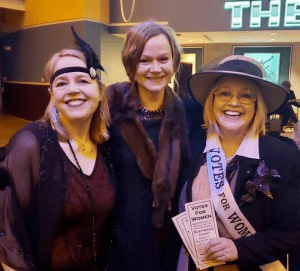
Putnam president/CEO Rachael Mullins (right) celebrated November 2019’s “Decadence on Division” fundraiser as a suffragette.
In addition to the Putnam board and committees, people she’s partnering with on the effort include:
- Ryan Saddler, founder and CEO of the Friends of Martin Luther King Interpretive Center in Davenport. He served as a facilitator when the Putnam hosted the exhibit “Race: Are We So Different?” The Putnam is working with the center’s African American History Advisory Committee. “We are partnering on the content with the intent that the content will also be hosted at the interpretive center, so we are essentially co-hosting the exhibit,” Mullins said.
- Mike Reyes, officer and past president with League of United Latin American Citizens (LULAC) Council 10, who was an important partner with the 2011 “Mi Casa Nueva” exhibit on Q-C Mexican history, and has continued to pursue important stories and artifacts from the Hispanic community of the Quad-Cities.
- Gaye Burnett, executive director of the Azubuike African American Council for the Arts, who has served on several committees helping guide Putnam exhibits, including most recently the “Liberated Voices/Changed Lives” exhibit on the Q-C women’s suffrage story. Azubuike, including Gaye’s son Jonathan Burnett, will lead video production for the stories being collected from the community starting this winter.
- Joanne Jones-Rizzi, vice president of science, equity, and education at the Science Museum of Minnesota (SMM). Co-creator of the “Race” exhibit, which started at SMM in 2007, she has joined as an advisor to the Putnam, which aims to work with other SMM departments as design and content consultant and evaluator. Jones-Rizzi will help integrate the themes of heritage, inclusion, and identity from the “Race” exhibit, which came to the Putnam in January 2019, staying 17 weeks.
The Putnam is also working with other organizations, including World Relief (which assists refugees moving to the area), Native American Coalition of the Quad Cities, plus the Boys and Girls Club and other youth organizations.
“Because of the unique impact on children and the importance that they see themselves in the work at the Putnam, and the history and heritage of our community,” Mullins said.
“2020 will be another one of those moments that goes down in history,” she said. “We’re doing a lot of collecting and storytelling around, to make sure future citizens of the Quad-Cities know how this community really cared and worked hard to address the needs of the pandemic, and who we were at the time.”
The new exhibit will include a reflection area they plan to shape around contemporary themes, Mullins said.
“Whether it’s social justice issues in the community or current events, looking back at the milestones of our community to come together and prioritize what were those moments in our shared experience that will become our history?” she said.
They’re working with the public to decide what should be saved for future generations.
“The events of 2020 really inspired this approach, but we anticipate this will be an annual activity at the Putnam,” Mullins said.

An image from the “Race: Are We So Different?” exhibit.
She wants to apply lessons of “Race” through a local lens – “how those ideas of inclusion and identity can be represented at a local level, through very specific stories of heritage,” she said.
“It’s proven to be a wonderful opportunity for us,” she said. “We’ll be consulting with Science Museum of Minnesota on conceptualization and evaluation of the exhibit, to make sure we’re on track.”
“It’s a remarkable time for museums,” Mullins said. “Museums are considered one of the most trusted institutions in the nation. So, it’s understood there’s a place for us, especially in highly controversial areas, to act as a safe space for dialogue, reconciliation and healing. Those are some of the themes coming through the United Way Equity Summit going on right now, in the United in Equity initiative.”
The Putnam wants to provide accurate portrayals of diverse role models, entrepreneurs, and tell stories of the accomplishments of a more diverse population in the area.
The Putnam is in a unique position, Mullins said.
“It’s an opportunity but it’s also an incredible responsibility – that we will likely host every school child in the region at least once in their childhood, which is remarkable,” she said. “We feel an incredible responsibility that every child sees themselves in the community, in the life of the community and history of the community.”
For children to understand not only what’s come before them, but the opportunities and responsibilities they have, will have an “immeasurable impact on their lives but also on the lives of the Quad-Cities region,” Mullins said.
One of the most interesting aspects of the project is that in addition to objects and documents, there will be digital content for storytelling, she noted.
Aligning with United Way equity efforts
Last month, Mullins and Jones-Rizzi participated in a Zoom meeting organized by United Way Quad Cities, on how to implement ways to improve racial equity.
“It’s really great to see and hear all the involvement from so many different groups,” Jones-Rizzi said then. “That’s really exciting and is core to how I like to think of the work.”
“We could not have done it without collaboration. For me and our work at the museum, collaboration is the key to everything we do,” she said. “We are not the kind of museum that comes up with an idea, announces to the world we’ve done something. We work with the content
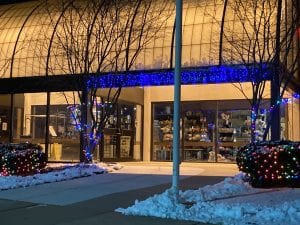
A view of the modified Putnam entrance at night.
experts, within the situations we’re situated in, to develop that content.”
“So much of what we do in museums is as translators and synthesizers,” Jones-Rizzi said. “Our job is to synthesize these ideas, translate them into experiences.”
A big part of her museum’s working with the American Anthropological Association in 2007 and wanting to do the traveling “Race” was “to create a catalyst for people to talk about race, for people to talk about larger systems of oppression,” she said.
“Every community is different in how you approach a theme, a problem, how you approach a concern, how you come together,” Jones-Rizzi said. A museum is a catalyst for larger community involvement and engagement, she noted.
She said Friday that traditionally, museums have been pretty white and elite institutions, which must change.
“To involve the community in the content, how you’re going to identify artifacts, what stories you’re going to tell — all these aspects, all their partners, people identified to work with, they have a deeper understanding, that they’re trying to repair decades and centuries of complicated relationships museums have with their community,” Jones-Rizzi said.
“People from the community will see themselves and their community reflected in this exhibition,” she said.
“That’s what museums do – we’re synthesizers, we translate it, synthesize it into something that’s experiential,” she said. “The relationships have to be real, so transparency is really important; expectations are really important. We can’t take every story we hear, being really clear,
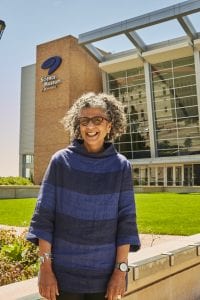
Joanne Jones-Rizzi is VP of science, equity and education at the Science Museum of Minnesota.
you’re not setting up a failure.”
“They are doing what I would say is authentic community engagement,” Jones-Rizzi said of the Putnam. “This is not connecting with people just because you’ll get the funding. This is wanting to be a truly responsive project. They’re connecting through what the United Way is doing, to connect to the community in a very authentic way, really be in a listening mode, and really listening to what the community is saying.”
“We need to be part of the community, not just in it,” she said.
The SMM (in St. Paul, Minn.) and Jones-Rizzi have worked with several museums around the country, doing similar consulting like with the Putnam. Both museums, like many nationwide, are doing more to digitize their collections to make them more accessible.
“Because of the pandemic, many museums are trying to digitize their collection., to make them accessible, so you can see the objects, while keeping people safe,” Jones-Rizzi said. “We have 2 million objects in our collection, and have been trying to do this for years.”
Saddler is one of three chairs for United Way’s African American Leadership Society, working to make a more equitable Quad-Cities.
“Part of what we are doing is, how do we educate our community on the history?” Saddler said. “If my worldview, how I present myself, is based on data which leads to assumptions, if that data is corrupt, my assumptions are corrupt. It shows up as a bias or whatever.”
Partnering between MLK Center and Putnam
The Friends of MLK, Inc. in Davenport was founded in 2016, to empower and encourage the area to practice the civil and human rights for all races, colors, and creeds as exemplified by the Rev. Dr. Martin Luther King Jr.
One of the goals of its Interpretive Center at 501 Brady St. is not to just treat the subject like a history class, just telling what happened, said Saddler, associate vice president at St. Ambrose University for diversity, equity and inclusion.
“Fast forward to now, what can we do, how does this inform how we are living now?” he said. “How do we change to make things better for us, and our community as a whole?”
 “It’s exciting, and it’s a challenge, but it’s exciting,” he said.
“It’s exciting, and it’s a challenge, but it’s exciting,” he said.
“The goal of the MLK Center is to tell cultural and ethnic stories that have been missing here in the Quad-Cities,” Saddler said recently. “We are starting with the Black and African-American story of Davenport. Our goal is to tell the cultural and ethnic story of the Quad-Cities — Black and Native American, Indigenous, Hispanic, Latinx, and not to step on toes of the German-American Center, but when you tell the story of Hamburg Gold Coast, you can’t miss the story of Germans and the Irish.”
“How do we tell the stories to reconstruct the mindset for all of us, teach young people the many contributions of so many people?” he said, noting they plan to open interactive kiosks next year. “That is one of our primary goals and missions.”
“The work of Dr. King, it fit well. With Dr. King, this whole idea of a dream, that we could all live together as brothers and sisters,” Saddler said. “How do we begin to have this collective impact, not just a Black impact or white impact, or Latinx/Hispanic impact? Have this collective impact that our predecessors here in Davenport did?”
“It’s good timing for us and for her, as she’s looking at redoing some things at the Putnam really focusing on the museum telling a more accurate story,” he said of Mullins. “It’s good for all of us.”
“We will be directing people to the Putnam, and they direct people to us,” he said. “Our goal — and we were very particular in calling it an interpretive center — our goal from the beginning not just to revisit history, but revisit history with the hope it enlightens us with how we move forward.”
“We lost a lot of history that should be captured; we did not have someone collecting it in real time,” Saddler said. “By them collecting this in
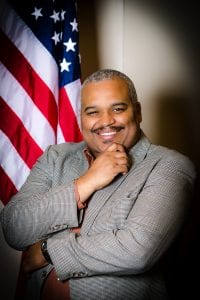
Ryan Saddler is founder of the Friends of MLK Interpretive Center in Davenport.
real time, it’s going to be informative for our kids, our grandkids. We collect information now, so that those stories can be told later. The error of our ways was, we didn’t do a very good job capturing and preserving our collective history. It wasn’t thought of.”
“It’s lovely the outlook they have on this,” he said. “In some ways it’s sustainability — they stay relevant if they collect things now, to stay in business. It’s important if we’re going to be looking to museums – who are best for preserving artifacts and stories. I think it is on them, with the libraries.”
The conversations around the “Race” exhibit were tough, Saddler said.
“After the events of this past summer, I think it’s an easier conversation to have,” he said. “The disappointing thing was, we didn’t have more people visit and learn from the exhibit. It did a really good job.”
“With the movement of Black Lives Matter, sparked with George Floyd, Breonna Taylor, the conversation was forced upon us, whereas before they were trying to push the agenda to have this conversation about race, which wasn’t easy,” Saddler said. “Now it’s forced upon us, we must have this conversation now.”
Society overall is in a better place now than we were a year ago, he said.
“We’ve been in conversations with nonprofits, the for-profit world, looking at policies, more entities are looking at anti-racist efforts — rather
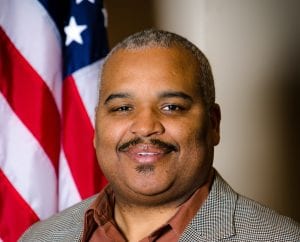
Ryan Saddler is St. Ambrose associate VP for diversity, equity and inclusion.
than just saying I’m not racist, really looking at policies,” Saddler said.
Contributions from Azubuike and Urban Exposure
Gaye Burnett, head of Azubuike African American Council for the Arts, said she and her son Jonathan will film interviews for the Putnam archives and exhibits.
“We would like to capture stories of the African-American experience in the Quad-Cities,” she said recently. “We’re not documented in the same way as others in the Quad-Cities.”
When Burnett worked on the women’s suffrage exhibit in the Putnam, she had a hard time finding information about Black women locally 100 years ago. “Nationally, we could find a lot of things, like in Chicago, but the closest we could find in our area was Iowa City, Black women who were active.
“There just wasn’t enough information; no one has been documenting us,” she said. “We wanted to be part of this project, so we could start getting stories. A lot of people have passed on, putting little pieces together. I still think that it’s valuable — it’s going forward to give other African-American youth some knowledge about who they were in this area, and who came before them.”
Jonathan is a Los Angeles-based filmmaker who heads the Urban Exposure Independent Film Project in the Q-C. They had to do the summer program all on Zoom this year.
“The Quad-Cities has grown over the years in its diversity, and has become not so much a melting pot, but more and more like a salad bowl,”
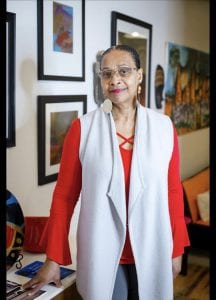
Gaye Burnett, executive director of Azubuike African American Council for the Arts.
he said recently. “We have people that retain their history, traditions and their culture. They’re all considered Quad Citizens. It’s a very important project from that standpoint.
“Being a young African-American man that grew up in the Quad-Cities, speaking to the Black community, I think documenting, archiving and showing Black stories in the Quad-Cities is not only important for the community, but also empowering,” Jonathan said.
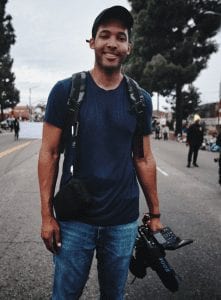
Filmmaker Jonathan Burnett runs the Urban Exposure summer program for students.
“Having the permanent exhibit just shows how serious the Putnam is about this project and how they know that education of the different communities within the Quad-Cities is important,” he said. “It’s a great step they’re taking towards inclusion of different backgrounds and cultures in the Quad-Cities.”
The Putnam effort also aligns well with United Way’s “United for Equity” program, he said.
“It’s mainly through education and empathy we start to rebuild that equity and equality in the Quad-Cities,” Jonathan said. “It very much goes hand in hand what the Putnam is doing for sure. It’s really all about the exposure, to different people or things, cultures and traditions. If you don’t grow, you don’t learn anything.”
His goal for Urban Exposure has been inviting underrepresented young people to tell whatever stories they’d like to tell, through film.
“Especially during the pandemic, people were talking about civil unrest in my classes, talking about inequality, systemic racism,” Jonathan said. “I think students, after doing this in 2020, we’ve been at it for six years now, a lot of students are starting to understand they can use film to share their stories, and the communities they come from. Urban Exposure is very interested in expanding that to another underrepresented group, to women in the Quad-Cities.”
Of the five students involved this year, just was one was female, and they made two short films, using Zoom. Topics addressed included civil unrest and the racial landscape in America, he said.
The Putnam also is working to create a diverse tapestry of stories, about the history of different local communities, Jonathan said.
“In the Black community, we want to hear the stories of the Black community in the Quad-Cities,” he said, hoping Urban Exposure can be part of it. “The role of film in raising awareness is a crucial one. We as a society are becoming, like we have people that read, but we have more people that watch.
“Watching content that tells impactful stories, that speaks to issues, it’s more effective,” Jonathan said. “When you have a story that speaks to issues, you follow a character, experience what the character is experiencing, see the character change and you see yourself in the character.”
Gaye Burnett was impressed with the “Race” exhibit. “I think the Putnam was really trying to be ahead of the game in getting that message out, starting that conversation, really deal with what are the things that are separating us,” she said.
“There’s only one race; there’s the human trace,” Burnett said. “These other things are things that divide us. To get people to see race relations, that there really is only one race, they should be commended for starting that narrative, having that dialogue on our community.”
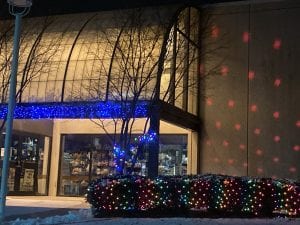
The Putnam Museum entrance (1717 W. 12th St., Davenport) lit up for the holidays.
“With this year, it’s extremely important,” she said of the Black Lives matter movement. “Why do all of the racial injustices, inequities, seem to be targeted to one group of people? We have to look at our history, see how slavery, the Jim Crow era impacted our lives. Black people are traumatized from it, but in a way, white people are traumatized too, having to live with that animosity.”
“You can’t see people, engage with people, have a really full, rich relationship, if you’re always looking down on people, that they’re less than you, not deserving of what they get.”
With the nationwide social unrest, we have to look at why police are killing Black people, Burnett said.
She started Azubuike in 2014, and their mission fits well with the Putnam. The council’s goal is to reconcile the racial divides that exist in our community through the arts.
“We’re trying to tell the stories of the community, doing it in a way where it embraces art and historical things,” Burnett said. “They have a slightly different mission, but with this project, we have aligned our mission, looking at racial injustice and inequities. When you go through the Putnam, what collections do you have? Everyone has a history, especially other people that live here.”
Reflecting the growing Hispanic population
Like the rest of the nation, the Latino population in the Q-C has been growing by leaps and bounds in recent decades. LULAC has partnered often with the Putnam, including bringing University of Iowa Libraries Mujeres Latinas archive, “establishing best practices, facilitating our training, and providing access to important Quad-Cities content from their archive,” Mullins said.
Mike Reyes of Bettendorf has served as LULAC Council 10 Davenport president from 2008-2014, and LULAC of Iowa state director from 2014-2018.
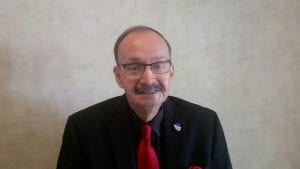
Mike Reyes is past president of LULAC Council 10 and state director of the Iowa chapter.
He worked with the Putnam not only on the 2011 exhibit on local Mexican-American history, but also the museum’s Davenport civil rights exhibit in 2010 – which also was a partnership with St. Ambrose and the Davenport Civil Rights Commission.
The “Mi Casa Nueva” exhibit was very well-received, especially by the Latino community, Reyes said. “It was kind of a turning point. There’s a lot of untold history. Along with the University of Iowa ‘Migration is Beautiful’ history exhibit, it all came together.
“It was kind of a launching point for us,” he said. “We are still trying to introduce Iowa Mexican and Latino history into the Davenport school district, West Liberty, and Muscatine.”
LULAC also has done volunteer work on other exhibits, including the “Race” exhibit, providing facilitators for that. “That was another positive initiative from the Putnam to our community,” Reyes said.
The “River, Prairie, People” exhibit is limited and “doesn’t show a complete picture of the Quad-Cities,” he agreed. “We need to expand that exhibit to show more diversity, as well as more history of what really happened in the Quad-Cities, within the communities of color.”
Council 10 also works with the Illinois-side LULAC Council 5285, based in Moline. They both have scholarship programs, but Davenport’s is much older, stretching back 61 years – awarding $600,000 to over 900 area students during that time, Reyes said.
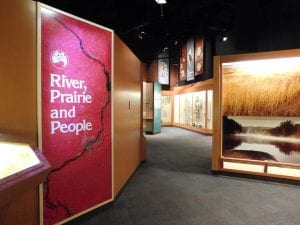
The entrance to the Putnam’s “River, Prairie and People” exhibit.
A better exhibit will help reduce stereotypes about immigrants, he said.
“Everybody thinks immigrants are here taking jobs; a lot of people talk of Americans not wanting to do those jobs,” Reyes said. “It goes further — there’s not enough Americans to do the jobs, there’s such labor shortage and need, in agriculture, construction, service industries.”
“It only makes sense to reach out to the immigrant community, if you don’t or won’t have enough labor force to get the work done,” he said. “It’s not a matter of who is stealing jobs; it’s a matter there’s not enough labor to sustain what the United States needs. What Congress really needs to be doing is immigration reform, give immigrants legal work permits, allow them to come to fill these jobs.”
The Putnam can help educate people about the importance and role Latinos have played in building the Quad-Cities, Reyes said.
“To educate both Hispanics and non-Hispanics about the rich cultural history that has been brought to the Quad-Cities,” he said.
“We always have a good relationship with the Putnam. They’ve been very open and honest with us,” he said. “History is important – kind of an untold history, especially the impact our community has had in the Quad-Cities. It’s more than education or jobs. If you look at Hero Street in Silvis, come to Council 10, you see a wall of veterans’ names, people killed in wars. The Latinos in the Quad-Cities have been very supportive of the military, participated in the military probably in greater amounts than people realize.”
The future of “Race” and the Minnesota museum
“Race: Are We So Different?” opened at the Putnam Jan. 26, 2019, encouraging visitors to explore human variation and its impact on our lives. It was developed by the American Anthropological Association in conjunction with the Science Center of Minnesota and funded by the National Science Foundation and Ford Foundation.
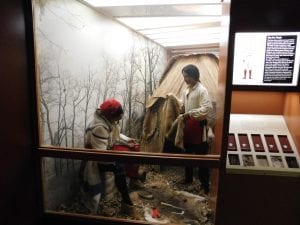
Part of the “Putnam, Prairie and People” exhibit.
When the SMM show opened in St. Paul on Martin Luther King Day 2007, the museum received 6,285 visitors that day alone.
The look at race and racism in the U.S. uses interactive components, historical artifacts, iconic objects, photos, multimedia presentations and graphic displays, according to understandingrace.org. It helps visitors look at race from three different perspectives — biology, history, and contemporary lived experience. The three perspectives are woven together to tell a compelling story of science with deep and lasting social impact, according to www.smm.org.
The original exhibit has been seen by more than 4 million people in 51 museums across the country since its debut in 2007.
The SMM is updating it with new data, videos and interactive features, to open again March 1 in person and a virtual exhibit, Jones-Rizzi said. The opening will feature talks by Lonnie Bunch, Secretary of the Smithsonian Institution, and Jonathan Capehart, a Washington Post and MSNBC journalist.
A special new video will be a memorial to honor unarmed Black people murdered by police in 2020 in the U.S. It will last exactly 8 minutes and 46 seconds – the time Minneapolis police officer Derek Chauvin had his knee on the neck of George Floyd on May 25, which killed him and sparked worldwide protests. Chauvin has been charged with second-degree murder and manslaughter, and faces trial this March.
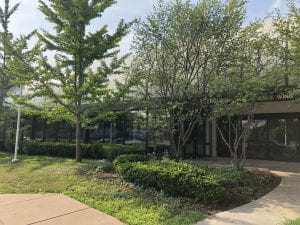
Since July, the museum has asked visitors to enter right off the parking lot.
Compared to 13 years ago, the environment in 2019 was much different, where people were more comfortable talking about race, Jones-Rizzi said of the Putnam discussions on the issue. “Many museums tried to do this; many museums didn’t succeed. That’s in some ways, the beauty of the exhibition, people took it and adapted it to whatever the community wanted, what the museum wanted to work on.”
“The Putnam work was really exciting,” she said. Museums are right to adapt exhibits to meet current needs, regardless of what is going on in the rest of the country.
“Many museums responded to what happened to George Floyd,” Jones-Rizzi said. “I think what differentiates the Putnam and differentiates us, those statements are not made in a vacuum. There’s something behind the statement, work they’re doing, collaborating, and co-creating is really important. It’s not a museum saying these are things we’re going to give you. They’re asking, what do you need, how can we do this together?”
The Minnesota museum is much larger than the Putnam, and pre-pandemic, it had 500 employees (the Putnam has 20).
“There are many museums that will not survive this,” Jones-Rizzi said. “Museums are so important to people and to people’s lives. I think part of that, some of that has to do with the fact, some museums have endowments — we don’t have a huge endowment.”

The Putnam Museum and Science Center Grand Lobby and Giant Screen Theater remain closed.
“People think of us as elite institutions, not in need of any kind of aid, and that’s not the case,” she said. “Museum staff, like the visitor-facing staff, people paid hourly, those are people who have lost their jobs, because we don’t have any visitors.”
This past spring, her museum was “clueless about the intensity of this,” Jones-Rizzi said of the pandemic, noting they didn’t reopen until late August. The Putnam opened with new restrictions and a new entrance in July.
The SMM is down to a little more than 200 employees now, and was open just Friday to Sundays, but the Minnesota governor a month ago closed restaurants, gyms and museums, so SMM closed as well.
“We are a science museum, so decisions we make about closure and opening have to be based on science,” Jones-Rizzi said. “It felt irresponsible to me to be open.” Her museum plans to be closed through March 1. “It’s tough.”
The Putnam is open Wednesday to Sunday, from 10 a.m. to 5 p.m., and advanced ticketing is highly encouraged. Limited areas of the Science Center are open only Saturdays and Sundays. The Giant Screen Theater remains closed.
Mullins said she hopes for a more traditional spring season, including reopening of the Giant Screen Theater, at first for school groups, and

Part of the “Putnam, Prairie and People” exhibit.
by summer be open to the public.
“A majority of the school visits and the Immerse program will wait until next school year,” she said.
United Way seeking applications by Jan. 8
United Way Quad Cities is accepting applications for its new United for Equity Fund grants, with a total of $200,000 to distribute — supported by local business and industry leaders as well as individual gifts. Applications will be accepted through United Way’s website until noon Jan. 8.
United for Equity Fund grants will vary in size depending on the needs of applicants, as approved by the review panel in February. There is no minimum or maximum amount applicants can seek.
However, given the fund’s three priorities of strengthening families, empowering the next generation and educating and equipping the community, grants will be awarded to multiple needs and not one single recipient.
To apply, visit www.unitedwayqc.org/apply. For more information, email Karrie Abbott at kabbott@unitedwayqc.org or call 563-344-0330.


